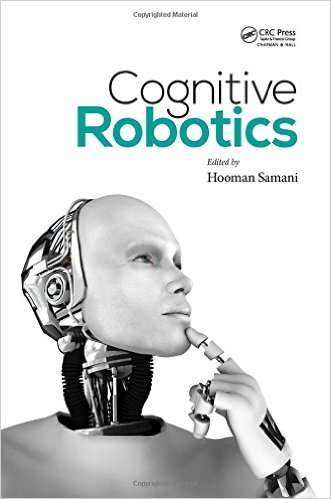
【内容简介】
The kimono-clad android robot that recently made its debut as the new greeter at the entrance of Tokyo's Mitsukoshi department store is just one example of the rapid advancements being made in the field of robotics.
Cognitive robotics is an approach to creating artificial intelligence in robots by enabling them to learn from and respond to real-world situations, as opposed to pre-programming the robot with specific responses to every conceivable stimulus.
Presenting the contributions of international experts from various disciplines within the field, Cognitive Robotics provides novel material and discusses advanced approaches in the field of intelligent robotics. It explains the various aspects of the topic to provide readers with a solid foundation on the subject.
This edited collection presents theoretical research in cognitive robotics. It takes a multidisciplinary approach that considers the artificial intelligence, physical, chemical, philosophical, psychological, social, cultural, and ethical aspects of this rapidly emerging field. The editor is a prominent researcher whose Lovotics research into emotional bonds with robots is widely recognized.
Supplying an accessible introduction to cognitive robotics, the book considers computational intelligence for cognitive robotics based on informationally structured space. It examines how people respond to robots and what makes robots psychologically appealing to humans.
The book contextualizes concepts in the history of studies on intelligence theories and includes case studies of different types of robots in action. Although ideal for robotics researchers and professionals, this book is also suitable for use as a supporting textbook in advanced robotics courses at both the undergraduate and graduate levels.
【目录】
SECTION I: ETHICAL ASPECT OF COGNITIVE ROBOTICS
When Robots Do Wrong; David Levy
Introduction
Blame the Robot?
The Robot as a Quasi-Person
The Robot as a Quasi-Animal
The Robot as a Man-Made Object
Punishing the Robot
Blaming the Robot - Summary
Blaming Homo Sapiens
A Question of Trust
Negligence and Product Liability Laws
The First Robot Fatality
Robots and the Laws of Negligence
Robots and the Laws of Product Liability
When Robots are Modified or Misused
Other Considerations of Legal Responsibility
Summary of Legal Considerations
Robot Cars
Insurance
Summary and Conclusions
Bibliography
SECTION II: PHILOSOPHICAL ASPECT OF COGNITIVE ROBOTICS
Designing Modular AI Robots Inspired by Amerindian Material Culture
Introduction
Evolution of Technology and Ideas
The Amerindian World and the Techno– Animistic Paradigm Shift
Animism: Material & Metamorphosis
Egalitarian Societies
Formation of a Robotic Community
Conclusion
Bibliography
SECTION III: CHEMICAL ASPECT OF COGNITIVE ROBOTICS
A Learning Planet; Hans Sprong
Introduction
Perspective
The Second Law
The Control of Fire
Emergence of Learning
Of Men and Centaurs
The Great Escape
Bibliography
SECTION IV: PHYSICAL ASPECT OF COGNITIVE ROBOTICS
Embodiment in Cognitive Robotics: An Update; Paolo Barattini
Introduction
Talking Chinese, Meaning and Recent Theoretical Debate
Recent Practical Implementations of the Embodiment of Emotions, Motivations and Intentional States
Conclusions
Bibliography
Imagined Physics: Exploring Examples of Shape-changing Interfaces; Tim R. Merritt, Mie Nørgaard, Christian Ø. Laursen, Majken K. Rasmussen , and Marianne G. Petersen
Introduction
Shape-Changing Interfaces
Examples from Our Courses
Shape-Changing Tumbling Objects: bObles
Shape-Changing with Light
Shape-Changing Surfaces
Imagined Physics
Movement and Incidental Effects of Actuators
Future Work
Acknowledgements
Bibliography
SECTION V: CULTURAL & SOCIAL ASPECTS OF COGNITIVE ROBOTICS
Effects of Cultural Context and Social Role on Human - Robot Interaction; Pei-Luen Patrick Rau and Na Chen
Introduction
Effects of Cultural Context
Factors Influencing Human - Robot Interaction
Effects of Cultural Context on Decision Making
Effects of Robots’ Social Role: Autonomy
Level and Group Orientation
Social Robots
Autonomy level of robots
Group orientation
Effects of robots’ social role on decision making
Future Work
Bibliography
A Cognitive Model for Human Willingness to Collaborate with Robots
Introduction
A Cognitive Model for Determining Human Willingness to Engage with Collaborative Robots
Determinants
Control Beliefs
Behavioral Beliefs
Normative Beliefs
Cultural Robotics
Future Research
Conclusion
Bibliography
Social Cognition of Robots during Interacting with Humans; Alex Yu-Hung Chien and Von-Wun Soo
Introduction
Speech Acts and Dialogue Context
Model Speech Acts As Dialogue Context Change
Multiple Dialogue Contexts
Physical Context
Emotion model
Social Relation
Social Role
Personality
Preference
Speech Act Model with Multiple Contexts
Context Awareness in Dialogue
Computational Model of Context Awareness Reasoning Using DBN
Noisy-OR Model
Isolated Contexts
Experiment
A Speech Act Model with Multiple Contexts
Infer Social Context from Dialogue
Noise in Dialogue Context Awareness
Pragmatic Prediction with Dialogue Contexts
The Most Likely Pragmatic Speech Acts Sequence
Conclusion
Bibliography
SECTION VI: PSYCHOLOGICAL ASPECT OF COGNITIVE ROBOTICS
On the Crossroads of Cognitive Psychologyand Cognitive Robotics; Roy de Kleijn, George Kachergis , and Bernhard Hommel
Early History of the Fields
History of Cognitive Psychology
The Computer Analogy
Early Cognitive Robots
Action Control
Introduction
Feedforward and Feedback Control in Humans
Feedforward and Feedback Control in Robots
Robotic Action Planning
Acquisition of Action Control
Introduction
Human Action-Effect Learning
Traditional Action-Effect Learning Research
Motor Babbling
Robotic Action-Effect Learning
Directions for The Future
Introduction
Affordance Learning
Everyday Action Planning
Conclusion
Bibliography
SECTION VII: ARTIFICIAL INTELLIGENCE ASPECT OF COGNITIVE ROBOTICS
A Bottom-Up Integration of Vision and Actions To Create Cognitive Humanoids; Jürgen Leitner
Introduction
A Cognitive Robotics Approach
Perceiving the Environment
Object Detection: icVision & CGP-IP
Interacting with the Environment
Collision Avoidance andWorld Model: MoBeE
Action Repertoire: TRM & LEOGrasper
Integration
Closing the Action-Perception Loop
Results
Avoiding a Moving Obstacle
Reaching and Grasping Objects
Conclusions
Bibliography

 新书报道
新书报道